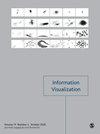将正交平面图形图画作为图形迷宫进行视觉编码:眼动追踪研究
IF 1.8
4区 计算机科学
Q3 COMPUTER SCIENCE, SOFTWARE ENGINEERING
引用次数: 0
摘要
以节点链接图的形式直观表示关系数据有多种样式。特别是对于平面图,我们可以发现正交节点链接图是一种成功而突出的变体,它由仅呈九十度弯曲的链接组成。这种图的好处之一是,由于链接方向、变化和变异的数量有限,可以用眼睛追踪网络中的较长路径,但不利的一面是,链接可以有任意的弯曲形状。在这篇文章中,我们开发了一种新方法,利用迷宫将这种正交平面图可视化,由于许多人都熟悉类似街道的视觉隐喻,这种迷宫对人眼来说看起来更自然。追踪路径是此类图形可视化的主要任务之一,与正交节点链接图类似,但我们认为迷宫是一种更自然的寻找路径的方法。为了深入了解阅读图形迷宫时的视觉扫描行为,我们对 26 名不同经验水平的男性和女性参与者进行了眼动跟踪比较研究,同时交替使用正交节点链接图和图形迷宫以及不同的图形大小水平。这项比较研究的主要结果是,参与者可以追踪两种表现方式中的路径,包括视觉搜索行为中的测地路径倾向,但在迷宫中通向测地路径倾向相反方向的分支节点和位置,通常会有较长的固定时间,这可能是观看者在视觉扫描行为中不得不开始一个重新定向阶段。我们还发现,图形顶点的大小(即图形顶点的数量)对正交节点链接图和街道迷宫的视觉扫描行为都有影响,但与节点链接图相比,我们发现对迷宫的影响较小(从眼动数据指标固定持续时间和囊状移动长度来看)。最后,我们讨论了我们方法的局限性和可扩展性问题。此外,我们还对未来可能的扩展工作进行了展望。本文章由计算机程序翻译,如有差异,请以英文原文为准。
Visually encoding orthogonal planar graph drawings as graph mazes: An eye tracking study
There are various styles to visually represent relational data in the form of node-link diagrams. In particular, for planar graphs we can find orthogonal node-link diagrams consisting of links bending only at ninety degrees a successful and prominent variant. One of the benefits of such drawings is the tracking of longer paths through a network with the eyes due to their limited number of link orientations, changes, and variations, but on the negative side the links can have arbitrary bending shapes. In this article we developed a novel way to visualize such orthogonal planar drawings by making use of mazes that look more natural to the human eye due to the street-like visual metaphor that many people are familiar with. Tracking paths is one of the major tasks in such graph visualizations, similar to orthogonal node-link diagrams, however, we argue that mazes are a more natural way to find paths. To get insights in the visual scanning behavior when reading graph mazes we conducted a comparative eye tracking study with 26 male versus female participants of different experience levels while also alternating between orthogonal node-link drawings and graph mazes as well as different graph size levels. The major result of this comparative study is that the participants can track paths in both representation styles, including a geodesic path tendency in their visual search behavior, but typically have a longer fixation duration at branching nodes and locations in the mazes that lead to opposite directions to the geodesic path tendency, maybe the viewers had to start a reorientation phase in their visual scanning behavior. We also found out that the size, that is the number of graph vertices has an impact on the visual scanning behavior for both orthogonal node-link diagrams as well as street-like maze representations, but for the mazes we found this impact to be less strong (in terms of the eye movement data metrics fixation durations and saccade lengths) compared to the node-link diagrams. To conclude the article, we discuss limitations and scalability issues of our approach. Moreover, we give an outlook and future work for possible extensions.
求助全文
通过发布文献求助,成功后即可免费获取论文全文。
去求助
来源期刊

Information Visualization
COMPUTER SCIENCE, SOFTWARE ENGINEERING-
CiteScore
5.40
自引率
0.00%
发文量
16
审稿时长
>12 weeks
期刊介绍:
Information Visualization is essential reading for researchers and practitioners of information visualization and is of interest to computer scientists and data analysts working on related specialisms. This journal is an international, peer-reviewed journal publishing articles on fundamental research and applications of information visualization. The journal acts as a dedicated forum for the theories, methodologies, techniques and evaluations of information visualization and its applications.
The journal is a core vehicle for developing a generic research agenda for the field by identifying and developing the unique and significant aspects of information visualization. Emphasis is placed on interdisciplinary material and on the close connection between theory and practice.
This journal is a member of the Committee on Publication Ethics (COPE).
 求助内容:
求助内容: 应助结果提醒方式:
应助结果提醒方式:


